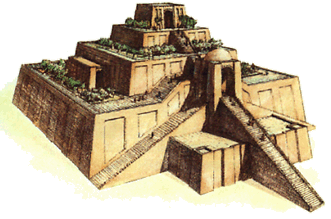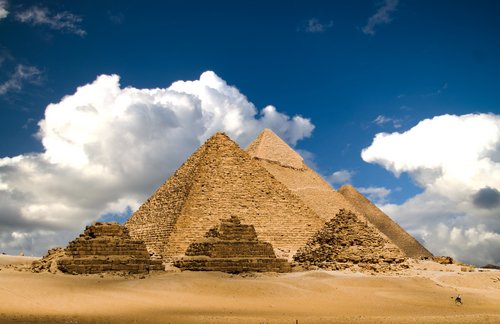Ancient Egypt & How it Compares.
Option #1
To compare the pyramids at Gizeh and the Ziggurats of the ancient near east, one must look to all aspects of each in order to do it properly. To begin with is the most obvious comparison, the juxtaposition of each structures appearance.
First, while looking at the Ziggurat in Ur we see a rectangle like structure with 3 sets of stairs all leading to the top where there is a series of smaller rectangles leading up to the top of the structure. However it still mostly retains its rectangular like feeling. Everything on a ziggurat is easily seen and it is massively decorated on the exterior to give of richness and holiness. Also, the ancient people of Ur Ur
Now on the other hand we have the Pyramids at Gizeh, most of their lavish decorations are on the interior tombs within the pyramids and the exterior (as it once was) was a simple white limestone with a golden tip. Where as this can be compared to the purity of the Gods of the time period, and is rather impressive in its own right, it was less a feature of timeless carving and detailing than as an overall structure. Also easily compared are the lack of staircases or any obvious means of entry into the Pyramids. They are perceived as one large structure in which only the Gods and the Ka of the deceased pharaohs could enter. Because of this, the main purpose of the pyramid could be found on the interior, not the exterior of this structure. Another obvious difference is the shape of both figures. The Ziggurat of Ur is very obviously shaped as a series of rectangles converging on top of one another, while the Pyramids are very delicately organized into a perfect rendition of one of the triangle family, a Pyramid. (a four sided 3D triangle)
While there are many differences between these two structures, there are also some similarities shared between them. They were both perceived as holy places for very important people to visit. They were both very large structures both for their time periods, as well as in general. They both took massive amounts of time to create, and great care and attention to detail on the planning and building. They were both revered by the people of the culture in the area, and finally, they were both created in a time period that only had man made tools and labor to construct the structures.


I like that you pointed out that the mud bricks used were not massive 2.5 ton blocks. Your quiet right a lot easier to create ziggurats with. Although slightly longer to create because it covers less area.
ReplyDeleteInteresting post, you brought up some things that hadn't been pointed out in some of the other post I read. The function of the pyramids being mostly interior and kind of exclusive as opposed to the function of the ziggurats being more external, yet both are providing access to the gods is really intriguing. These are really are impressive creations.
ReplyDeleteYou have some good points here. I would mention, though, that the pyramids also serve as a final resting place for the pharaoh. You did mention the tombs, so I can tell that you understand the funerary aspect of pyramids. I guess I just wouldn't use the word "visit" in connection with the pyramids, since that suggests that the time spent at the pyramid is temporary. For the deceased pharaohs, they wouldn't be going anywhere else after arriving at the pyramid!
ReplyDelete-Prof. Bowen
Good comparison, I think your understanding of the composition and how the structures were formed helps create a better visual for the reader. You helped your case by incorporating a lot of examples and interesting facts.
ReplyDeleteI like that you talked about the carvings on the Ziggurats, I would never have thought of that. I also wouldn't have thought about the different ways to enter each structure having to do with their differences. They really are quite different, even if they look similar.
ReplyDelete